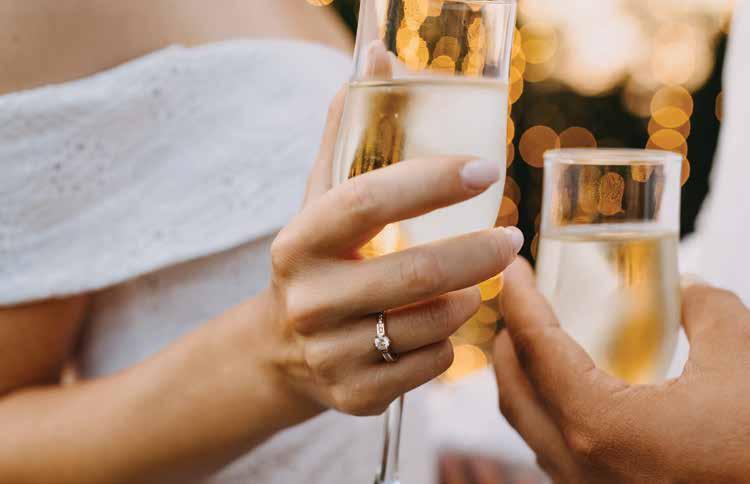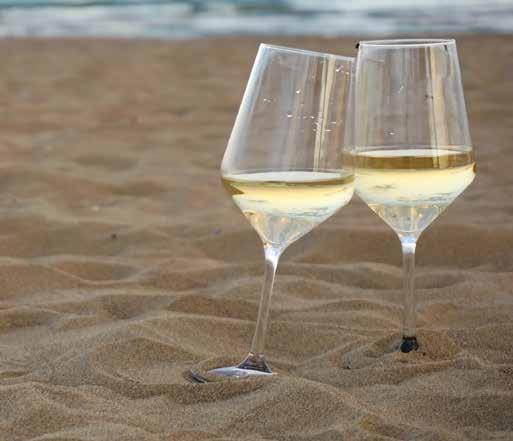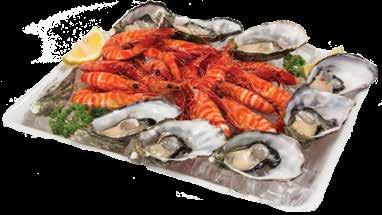
6 minute read
Winelander
Wine would have started out as an accident some five thousand years ago when some crushed wine juice left for some time probably with the skins started to ferment as the yeast on the skins reacted with the sugar in the juice to form alcohol. Champagne was also an accident when a bottle of wine which hadn’t fermented completely was left out to be covered by snow, when the snow melted and the warmth reactivated the fermentation in the bottle creating carbon dioxide and blowing the cork out of the bottle creating a sparkling wine which a monk called Dom Perignon described “I am drinking the stars”. From that moment Champagne was born and it is still created in the bottle to this day, although nowadays the yeast strains are added to the wine rather than waiting for nature. Dom Perignon went on to work with this new sparkling wine and help master the technique of creating first class Champagne by blending various grape varieties. Champagne is different to most sparkling wines in the fact that after a still wine is made by fermenting the wine in either stainless steel tanks or as some vineyards still do in large oak barrels, the wine is then transferred to bottles for the next phase of their life and this is indeed the same bottle you purchase some years later. In the production of most sparkling wine the addition of carbon dioxide to create the fizz takes place in the tanks in a similar fashion as soft drinks, the sparkling wine is then bottled and sold, vary rarely with any age. If the label carries the words “Made in the traditional way” or as in the case of Champagne “Methode Champenoise” or “Methode Traditionnelle” then you know with this wine and the creation of the sparkle was within the bottle itself and the lengthy process of making Champagne begins and why Champagne is more expensive than other sparkling wines.
winelander
Advertisement
TRADING HOURS

Monday - Thursday 10am-7.30pm Friday - Saturday 10am-8pm Sunday: 10am-7.30pm Visit us on facebook
Bribie Island. Ph. 3410 0084

Shop 3/12, First Ave, Service Road, BONGAREE (Across from Bongaree Car Park)
The grapes are mainly picked by hand between August and October and only the best ripened grapes are picked, the varieties comprising of Pinot Meuniere, Chardonnay and Pinot noir which represent over 95% of the grapes grown in Champagne and are with distinct boundaries outside of which no sparkling wine can be called Champagne, there have been moves recently to expand the region due to Champagnes popularity and a shortfall in the amount of wine that is produced. The juice from the grapes is fermented in tanks or large wooded barrels, a traditional way but much more complicated, and the sugar fermented completely out to produce a completely bone dry wine. The blending of the grape juice, usually five months after harvest, which is a completely white wine unless making a rose style then a small amount of skin contact is used from the Pinot Meuniere and The Pinot Noir, the juice from these grapes is white until then. The blended wine can be a blend of all three varieties and from different vintages as in the case of non-vintage Champagne or that vintage of harvest to produce a vintage Champagne which will carry the date of harvest, in the case of Blanc de Blanc only Chardonnay grapes are used. This is where each Champagne House differs by using various amounts of each variety, with Henri Laurent it is 85% Pinot Meuniere 15% Chardonnay and 5 % Pinot Noir and this blended wine is then bottled in the traditional style bottle reinforced with extra thickness for the pressure which is about to unfold. A mixture of yeast, yeast nutrients and sugar (liqueur tirage) is added to the wine and the wine is then sealed with a crown cap similar to a beer bottle and the secondary fermentation begins as the sugar and yeast react and the result is carbon dioxide forming naturally in the bottle. The wines are stored in cool cellars, often caves, and the fermentation takes place slowly. As the fermentation proceeds the yeast cell die and after several months the fermentation process is completed. The Champagne process is complete however the wine continues to age in the cellar for several more years resulting in a yeasty toasty character. The yeast cells split open and lie in the solution imparting complex yeasty flavours to the Champagne, the best and most expensive Champagnes can be aged for as long as five years but most are left for three years in the bottle and the secondary fermentation is now complete. After the aging process is complete the dead yeast drift down to the neck of the bottles in a process known as Riddling, this is where the bottles are fitted into the holes in a large rack at a 75 degree angle and turned daily by a 1/8th of a turn until all the dead cells are in the neck of the bottle, in the larger Champagne houses this is now completed by machine. This process was created by Madam Veuve Cliquot 206 years ago. To disgorge the dead yeast cells the neck of the upside bottle is frozen in ice-salt bath so that when the bottle cap is taken off the pressure inside the bottle pushes the plug of cells out of the bottle, and then a mixture of white wine, brandy and sugar (liqueur de tirage/liqueur d’expedition) is added to adjust the sweetness level of the wine and top up the bottle. This addition will now adjust the wine to what the winemaker is trying to achieve and will be labelled Brut Nature, Extra Brut, Brut, Extra Dry, Semi Dry or Doux. Now complete, the wine is now corked and then wired down and then transported around the world to be enjoyed by millions of Champagne worshipers every week. We shall revisit the wine districts of Australia soon.
Cheers - Philip Arlidge
arlidge@bigpond.com.au
Lily Bollinger was asked “When do you drink Champagne?”, and she replied. “I only drink champagne when I’m happy, and when I’m sad. Sometimes I drink it when I’m alone, when I have company, I consider it obligatory. I trifle with if I am not hungry, and I drink it when I am. Otherwise I never touch it-unless I’m thirsty”. Bette Davis from the movie OLD Acquaintance “There comes a time in every woman’s life when the only thing that helps is a glass of Champagne”.
BRISBANE CRUISES

Departs Bongaree Jetty, Bribie Island 12 noon Returns 2.00pm (approx) BRIBIE ISLAND LUNCH CRUISE 2022 Enjoy a relaxing lunch time cruise while we prepare a delicious BBQ lunch onboard the Lady Brisbane. Buy a GIFT CARD or BOOK Online now at www.brisbanecruises.com.au Price Includes BBQ lunch and cruise The cruise towards Skirmish Point, Gilligan’s Island Prices: Adults $44, Children $20 (4 - 14yrs). and Deception Bay is always a magical experience. 2022 DATES: Tue 3 May, Wed 1 June, Fri 1 July, Cruise route is weather dependent. Fri 1 Jul, Tue 16 Aug, Mon 26 Sept









